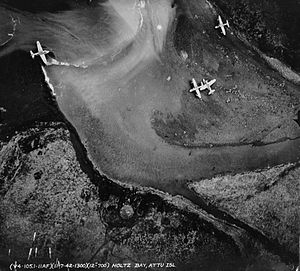| Japanese occupation of Attu | |||||||
|---|---|---|---|---|---|---|---|
| Part of the American Theater and the Pacific Theater of World War II | |||||||
 Four Japanese seaplanes landed at Holtz Bay, Attu Island on 7 November 1942. Photo taken by American surveillance aircraft. | |||||||
| |||||||
| Belligerents | |||||||
|
|
| ||||||
| Commanders and leaders | |||||||
| N/A |
| ||||||
| Strength | |||||||
| N/A | 1,140 - 2,900 | ||||||
| Casualties and losses | |||||||
|
1 civilian killed 46 civilians captured | Unknown | ||||||
The Japanese occupation of Attu (Operation AL) was the result of an invasion of the Aleutian Islands in Alaska during World War II. Imperial Japanese Army troops landed on 7 June 1942, the day after the invasion of nearby Kiska. Along with the Kiska landing, it was the first time that the continental United States was invaded and occupied by a foreign power since the War of 1812, and was the second of the only two invasions of the United States during World War II. The occupation ended with the Allied victory in the Battle of Attu on 30 May 1943.